- | Corporate Welfare Corporate Welfare
- | Policy Briefs Policy Briefs
- |
The State of Occupational Licensure in Michigan
When a state imposes licensing rules on an occupation, workers cannot legally practice that trade without fulfilling a set of requirements. When a state imposes certification rules on an occupation, noncertified workers can still legally practice their trade, but certification acts as proof of those workers having met certain state-defined professional benchmarks. About a quarter of Michigan’s workforce is licensed or certified. Occupational licensing is ostensibly intended to protect the public from unsafe and low-quality service, but there is little evidence that this intention is realized. Rather, there is a growing consensus among economists that these rules serve to protect incumbent providers from competition by creating barriers for new entrants, ultimately leading to higher prices for consumers.
Occupational licensing has expanded dramatically over the past 50 years. In 1950, 5 percent of the US workforce was licensed through state laws, and in 2000 that number approached 20 percent. When federal licenses are also accounted for, one estimate for 2006 is that 29 percent of the workforce was licensed. This growth in licensure arises primarily from the growth in the number of occupations for which the state requires a license, not from people switching from jobs that do not require occupational licenses to jobs that do. While there is a great deal of variation across states in the number of occupations for which a license is required as well as in the requirements to obtain a license, every state has seen an increase in both. Michigan is no exception.
A Snapshot of Michigan’s Occupational Licensure Regime
The government of Michigan has developed extensive licensing requirements. In 2013, the latest year for which data are available, the state licensed 20.6 percent of the workforce and certified another 3.3 percent. Michigan licenses 164 occupations, including such rarely licensed professions as animal control officer, painting contractor, and gaming supervisor.
A 2017 study by the Institute for Justice (IJ) examined occupational licensure laws for 102 lower-income occupations and found that Michigan requires a license for 49 of them. Obtaining a license poses many substantial hurdles. In assessing the burdens the state imposes—including fees, exams, age requirements, grade requirements, and training and experience requirements—the report ranked Michigan’s licensing regime as more broad and onerous than those of 21 other states. On average, the Great Lakes State requires 255 days of experience and training, $242 in fees, and approximately two exams for each of those 49 occupations. Gaming supervisors, makeup artists, painting contractors, and many others face steep fines for operating in Michigan without a license.
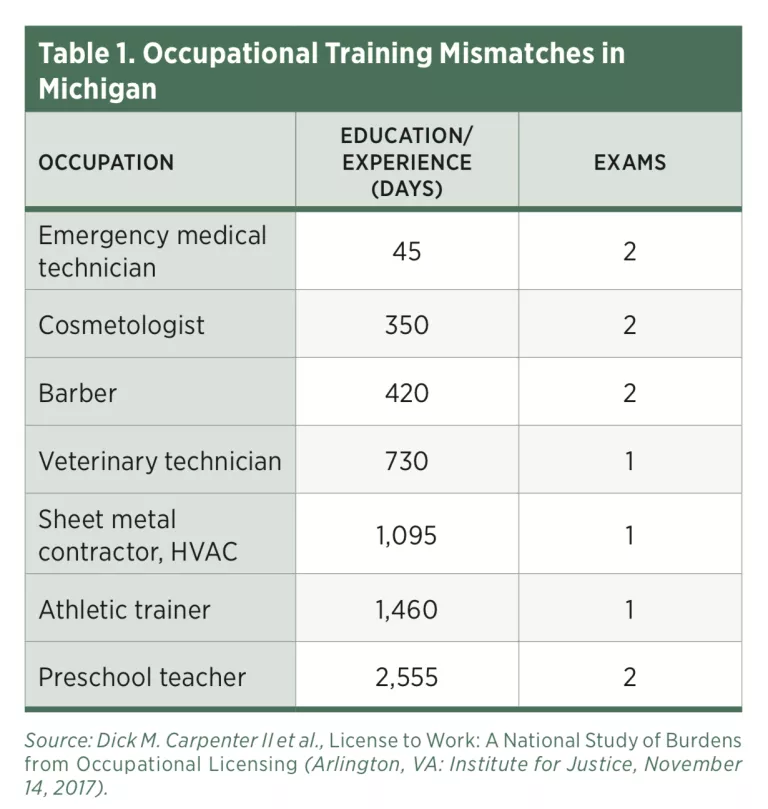
Patterns in occupational licensing requirements contradict the idea that licensure is primarily used to protect public safety. Occupations that are less likely to involve risk to the public are often more highly controlled than riskier occupations. For example, Michigan’s emergency medical technicians (EMTs) must complete 45 days of training and pass two exams before being licensed to work on an ambulance team. By contrast, Michigan’s sheet metal HVAC contractors must complete 1,095 days of education and experience—24 times the amount of training required of EMTs. Barbers, too, are subject to a full year more of training than EMTs—420 days in total. There are other inconsistencies in Michigan’s licensing regime. As a 2017 report from the Mackinac Center notes, tile and marble installation requires a license, but carpeting does not. Similarly, carpentry requires a license, but drywall installation does not. Additional regulatory mismatches are shown in table 1.
The evidence suggests that licensing requirements do not improve the quality of the goods and services provided by licensed occupations (see the next section), and that they exclude potential service providers who find the hurdles too costly to overcome. These hurdles limit competition for the incumbents in these protected trades, producing a doubly negative effect: First, occupational licensing requirements keep able people from entering trades they could otherwise learn quickly and perform sufficiently well, limiting employment opportunities for people without advanced skills or degrees. Second, protected industries can charge their customers higher prices than competitive industries, requiring everyone to pay higher bills for basic services. Low-income consumers lose in particular. In the absence of licensure, a barber, for example, might offer discounted haircuts with fewer frills to those who would otherwise not be able to afford luxurious shops.
There is significant variation in licensing requirements for the same jobs across states. Licensing boards can require a minimum level of education or experience, a steep processing fee, or a passing score on examinations. In Michigan, 27 of the 49 licenses highlighted by IJ require all three. All but two require the applicant to pay a fee, the highest of which is $1,045 for a fire alarm installer license.
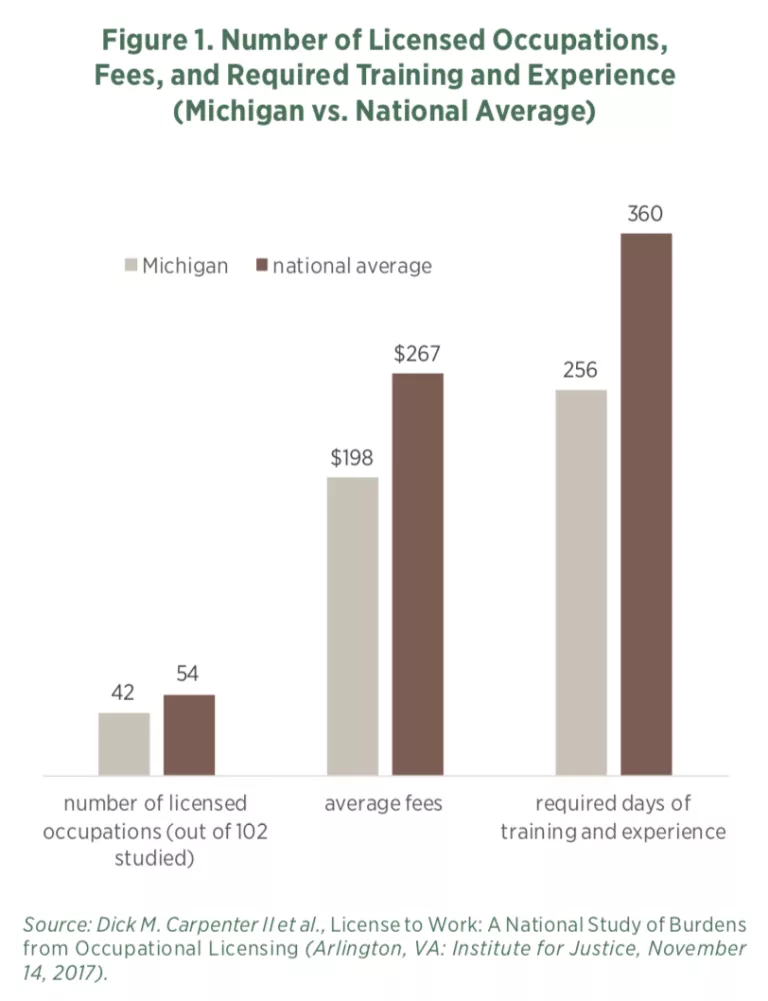
Figure 1 compares the state’s fee and experience requirements in these surveyed occupations to the national average. Michigan’s licensing requirements are slightly below the national average in three areas: number of occupations licensed, fees, and days lost to education and experience requirements.
Though for many professions Michigan has less restrictive laws than the national average, in some instances the reverse is true. For instance, Michigan’s licensing fees for fire alarm installers are among the highest in the country. Prospective fire alarm installers in Michigan must pay $1,045 before becoming licensed, nearly twice the national average fee of $557.
In fact, Michigan’s licensing requirements for several professions exceed the national average. Across the United States shampooers must complete 248 days of education and training. But in Michigan, shampooers face even higher barriers to entry in their profession. Prospective shampooers in Detroit must undergo nearly three and a half months more training—for a total of 350 days—before beginning work. By comparison, their counterparts in Indianapolis can get to work much sooner, since Indiana does not require a license for shampooers at all.
Industry domination of licensing boards is also a problem. Table 2 provides a snapshot of Michigan board composition in October of 2017. The Michigan Constitution is unique among all state constitutions in that it requires every occupational licensing board to have a majority of members who are license holders.
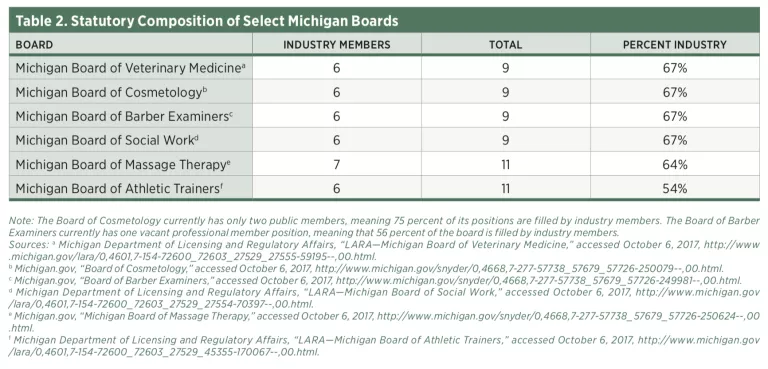
When industry members create the standards for entry into their profession, they have an incentive to implement burdensome entry requirements and protect themselves from competition. In effect, members are incentivized to make entry into their profession more difficult without necessarily making the public safer. In its 2015 opinion in North Carolina State Board of Dental Examiners v. FTC, the US Supreme Court addressed precisely this issue. It established a two-part test to determine whether a board controlled by market participants is immune from antitrust claims. In order to claim immunity from antitrust, (1) the state’s board composition requirement must serve a state policy goal, and (2) a given board’s activities must be subject to active supervision by the state. Even if Michigan can satisfy both requirements, its policymakers would be wise to consider alternatives to the current structure that might minimize the perverse incentives of board members. One option would be to eliminate the state constitution’s unusual requirement that a majority of all boards be license holders.
Instead of allowing monopolized boards, Michigan should structure its boards to include a broad array of experience, knowledge, and concern for the interests of the public. For example, they should include consumer representatives and representatives of organizations dedicated to support job placement. Boards should also include experts familiar with the economic literature on licensure.
Fortunately, policymakers in Michigan are trying to lower barriers in a variety of occupations. Governor Rick Snyder has signed eight different licensure reform bills since 2012, more than any other governor. Today, auctioneers, community planners, immigration clerical assistants, dieticians, nutritionists, ocularists, and school solicitors are no longer subject to burdensome licensing requirements in the Great Lakes State. Legislators have also eliminated the carnival ride board and reduced the educational requirements for barbers from 2,000 hours to 1,800 hours.
Michigan’s licensing reform efforts so far have been a good first step, but there is more to be done to make low- and middle-income occupations accessible to people who are most likely to be stymied by barriers to entry. Substantive economic evidence clearly points to the need for further reform. In the following section, we discuss the economics of occupational licensure. After that, we outline a path for reform in Michigan.
The Economics of Occupational Licensure
Licensure and Quality
Licensure is justified by legislators and advocates as necessary to protect the public from low-quality services or potential health risks. It is theoretically possible that a well-designed quality screening system will ensure that only high-quality professionals join an occupation. However, limiting the supply of professionals undermines competition. Less competition means lower quality and higher prices. As Morris M. Kleiner put it, licensure ensures that “prices and wages will rise as a result of restricting the number of practitioners, which should tend to reduce quality received by consumers.” High prices may even push consumers out of the market entirely, inducing them to resort to far more risky do-it-yourself behavior. For example, one study found that more restrictive electrician licensing regimes are associated with fewer electricians per capita and that this, in turn, is associated with more accidental electrocutions.
The true effect of licensure on quality is an empirical question, since economic theory suggests that licensure can have opposing effects on quality. Licensing requirements can increase quality by restricting entry only to highly qualified professionals, or it can decrease quality by causing less competition, higher prices, and more do-it-yourself activities. A number of studies have assessed the effect of licensure on quality, and the weight of evidence suggests that the two effects roughly cancel each other out. As Kleiner summarized in his review of the literature,
"There is little to show that occupational licensure has a major effect on the quality of services received by consumers or on the demand for the services other than through potential price effects."
During the Obama administration, the Department of the Treasury, together with the Council of Economic Advisers and the Department of Labor, issued a report (henceforth referred to as the Treasury Department Report) including a review of the literature that concluded,
"With the caveats that the literature focuses on specific examples and that quality is difficult to measure, most research does not find that licensing improves quality or public health and safety."
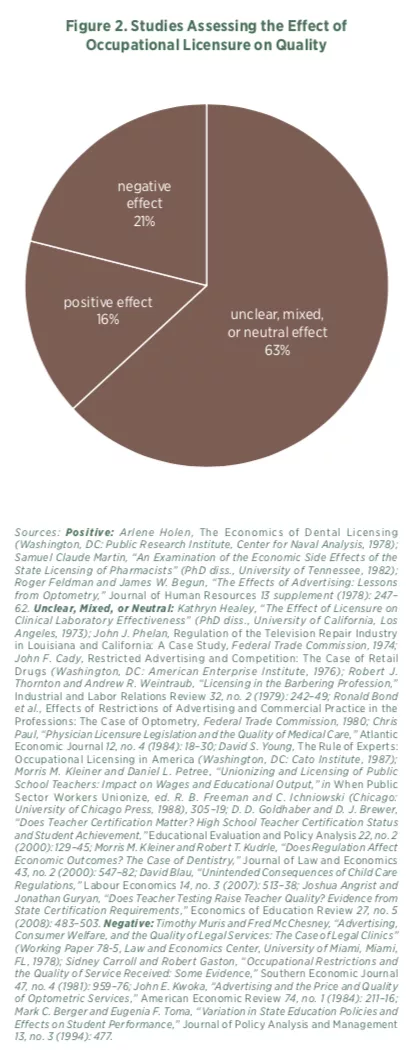
If occupational licensing were governed solely by the logic of promoting public safety, the same types of activities would be regulated in similar ways across states. In reality, there is wide variation across states in terms of the occupations regulated and the stringency of those regulations. For example, four states heavily regulate interior designers, requiring them to have on average nearly 2,200 days of education and experience to practice their trade. Interior designers are able to offer their services in other states free from regulation with no apparent risk to the public.
Licensure is not the only or the most effective way to ensure quality. Tort law and civil and criminal laws against deceptive trade practices protect consumers from fraud and negligence. Firms already scrupulously guard their reputations and brands and seek the approval of third-party evaluators such as the Better Business Bureau and Angie’s List. The internet and smartphone applications have made shopping comparisons easy for consumers and have balanced, to some extent, information asymmetries typical of specialized services. If policymakers think private measures are insufficient to protect consumers, a number of public regulatory options are more effective and less likely to be counterproductive than licensing. For example, the government can require that firms post bonds or simply register their businesses with the state so that consumers can be assured service providers are not fly-by-night operations.
Licensure and Prices
Economic theory predicts that a restriction in supply will result in higher prices. And, indeed, the empirical research consistently finds this to be the case. According to the Treasury Department Report,
"The evidence on licensing’s effects on prices is unequivocal: many studies find that more restrictive licensing laws lead to higher prices for consumers. In 9 of the 11 studies we reviewed . . . significantly higher prices accompanied stricter licensing."
Similarly, McLaughlin, Ellig, and Shamoun found that licensure increased prices in all 19 of the studies they surveyed, in occupations ranging from optometry and law to dentistry and cosmetology.
The effects of these increased prices are not trivial. For example, state nurse practitioner licensing is estimated to increase the price of a well-child checkup by 3 to 16 percent, dental hygienist and dental assistant licensing is estimated to increase the price of a dental visit by 7 to 11 percent, and optometry licensing is estimated to increase the price of eye care by 5 to 13 percent. What’s more, none of these studies found that licensing increased quality.
Licensure and Regulatory Privilege
Writing in the Harvard Journal of Law & Public Policy, Paul Larkin Jr. notes a “curious and stubborn fact: Private individuals rarely urge governments to adopt licensing regimes, but private firms often do.” This fact conforms with the economic theory of regulation, which suggests that incumbent providers may use licensure to limit competition. By limiting supply and raising prices, these rules allow incumbent providers to earn artificially high profits. Indeed, the latest research suggests that licensure raises the wages of licensees by about 14 percent. Occupational licensing is a privilege granted by a regulatory agency to incumbent providers.
The social costs of this privilege are shouldered, in part, by consumers who have to pay higher prices than they would pay in more competitive markets. But the social costs also include the wages not earned by potential providers who are effectively excluded from the market by these regulations. With both the high prices for consumers and the forgone wages of would-be competitors, society is likely to experience a net loss from occupational licensing—what economists call deadweight loss. What’s more, incumbent professionals are willing to expend scarce resources convincing policymakers to contrive and maintain these privileges, a socially wasteful endeavor known as rent-seeking. Being few in number and established in their fields, these license holders generally find it easier to get politically organized than the large number of consumers and would-be competitors who are harmed by licensure.
The Disparate Impact of Licensure
Those who fail to obtain licenses pay a price in the form of lost income. Research suggests that these burdens often fall on particular communities. For example, military spouses are more likely to be in licensed professions and more likely to relocate from one licensing regime to another.
Licensure also presents a higher barrier to immigrants since many states require domestic work experience. For ex-offenders, occupational licensing is particularly burdensome because most states make it impossible for those with a past conviction to obtain an occupational license.
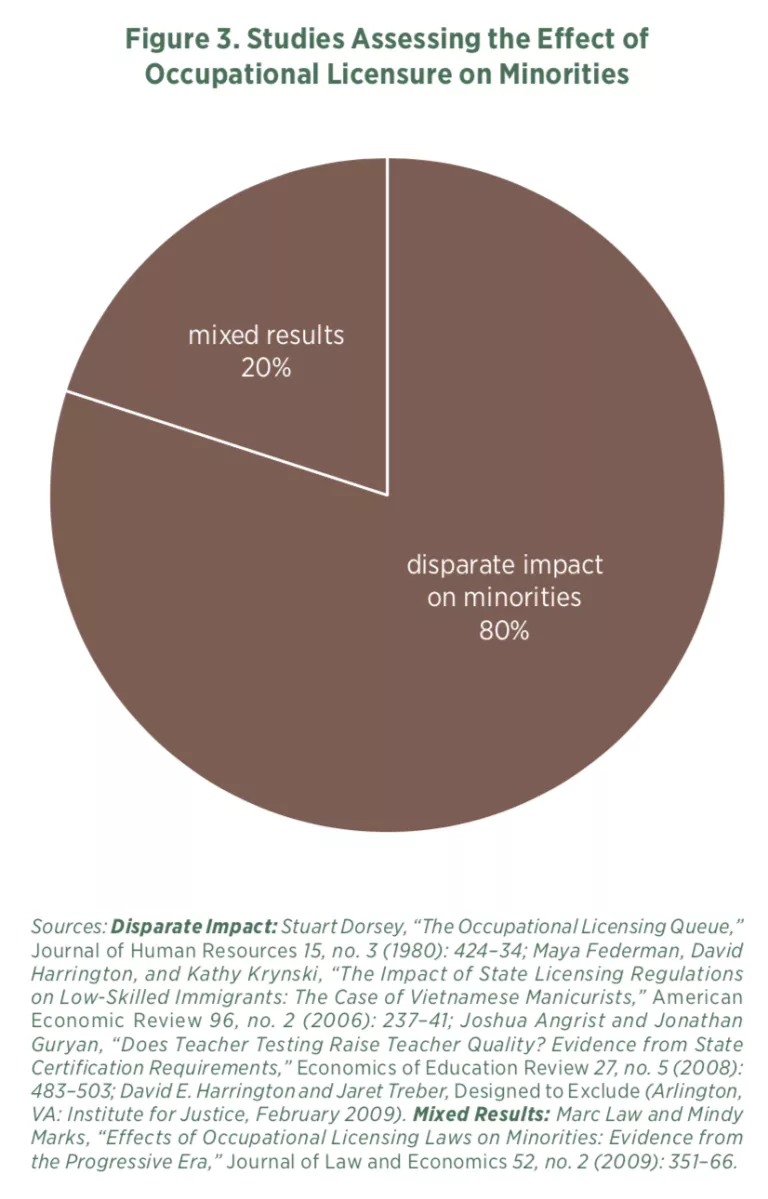
As shown in figure 3, McLaughlin, Ellig, and Shamoun’s survey of the literature shows that licensing was found to disparately affect ethnic minorities in four of five studies.
Licensure may also be associated with greater income inequality. In a recent study of 175 countries, McLaughlin and Stanley find that nations with more legal barriers to starting a business experience greater levels of income inequality. Furthermore, a new report by Meehan, Timmons, and Meehan finds that there may be a negative relationship between growth in licensure and economic mobility. The authors looked at growth in low-to-moderate-income occupational licensure across states and found that it negatively correlates with absolute economic mobility.
Reform
While occupational licensure is intended to protect consumers from harm, there are many other less burdensome mechanisms to promote public safety. For instance, liability law and civil and criminal laws against fraud protect consumers. In addition, a host of private mechanisms ensure that market providers are accountable. These include private certifications, insurance, bond-posting, brand reputation, customer review platforms like Yelp and Google reviews, and the third-party validation of organizations like Angie’s List, Consumer Reports, and Underwriters Laboratories. Competition itself may be the best alternative to licensure. As the economist Alfred Kahn put it after decades of extensive work as a regulator and researcher, “Whenever competition is feasible, it is, for all its imperfections, superior to regulation as a means of serving the public interest.”
Policymakers wishing to reduce the social costs of their state’s occupational licensing could take the following steps:
- Pass legislation that sets an ambitious goal for the elimination of licenses and the reduction in licensing burdens.
- Establish an independent commission charged with examining the state’s licensing laws. Its first task should be to identify each license the state requires as well as the burdens associated with each license (fees, exams, required training, education, experience, and other limitations). The commission should be charged with evaluating all licenses, should not be dominated by members of the licensed professions, should include consumer representatives and representatives from organizations devoted to assist job seekers, and should include third-party experts such as academics who have no financial stake in licensure. Furthermore, the commission should be guided by a set of criteria for evaluating regulations as listed in table 3.
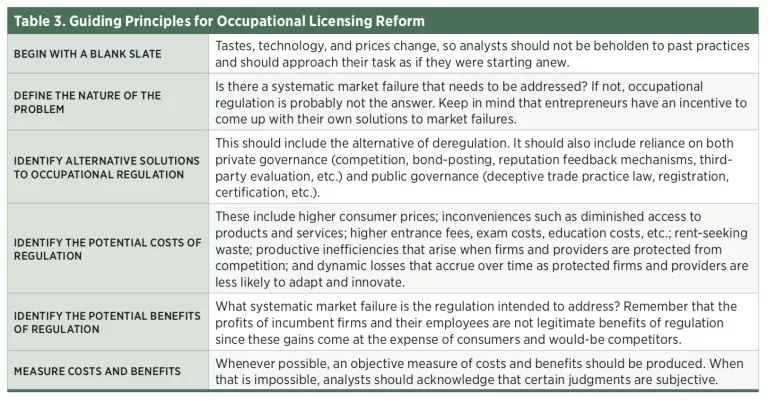
- The commission should be charged with performing a comprehensive review of all occupations, with the goal of identifying licensure requirements that can be eliminated or reformed. The authorizing legislation should commit elected officials to accepting the commission’s recommendations in their entirety or not at all.
The last provision is designed to overcome the public choice problems that plague licensure reform. In particular, whenever any individual license is evaluated, concentrated members of the industry are typically able to organize in defense of the license, while diffuse consumers and would-be competitors are unable to organize in opposition. The institutional structure that we recommend borrows elements from other reforms that have succeeded in eliminating favoritism. In particular, it allows elected officials to cast conspicuous votes in the public interest while giving them some degree of “cover” from the special interests that will inevitably be harmed by the elimination of their regulatory privilege.

